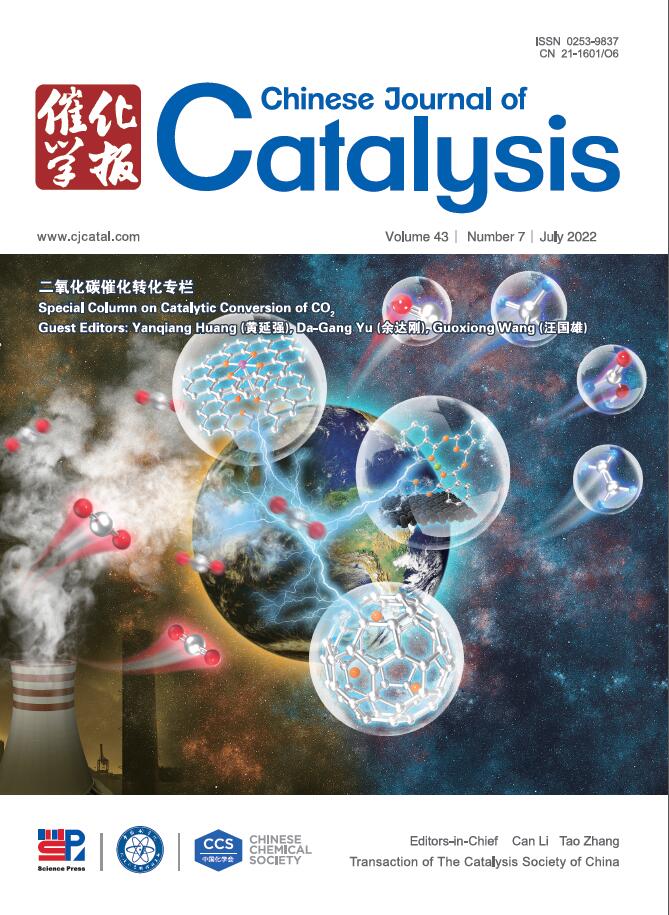Strong interaction between Fe and Ti compositions for effective CO2 hydrogenation to light olefins
IF 15.7
1区 化学
Q1 CHEMISTRY, APPLIED
引用次数: 0
Abstract
Fe-based catalysts are widely used for CO2 hydrogenation to light olefins (C2–4=); however, precise regulation of active phases and the balance between intermediate reactions remain significant challenges. Herein, we find that the addition of moderate amounts of Ti forms a strong interaction with Fe compositions, modulating the Fe3O4 and Fe5C2 contents. Enhanced interaction leads to an increased Fe5C2/Fe3O4 ratio, which in turn enhances the adsorption of reactants and intermediates, promoting CO hydrogenation to unsaturated alkyl groups and facilitating C–C coupling. Furthermore, the strong Fe-Ti interaction induces the preferential growth of Fe5C2 into prismatic structures that expose the (020), (–112), and (311) facets, forming compact active interfacial sites with Fe3O4 nanoparticles. These facet and interfacial effects significantly promote the synergistic coupling of the reverse water gas shift and Fischer-Tropsch reactions. The optimized 3K/FeTi catalyst with the highest Fe5C2/Fe3O4 ratio of 3.6 achieves a 52.2% CO2 conversion rate, with 44.5% selectivity for C2–4= and 9.5% for CO, and the highest space-time yield of 412.0 mg gcat–1 h–1 for C2–4=.
铁和钛成分之间的强烈相互作用促进二氧化碳有效加氢生成轻质烯烃
铁基催化剂广泛用于CO2加氢制轻质烯烃(C2-4 =);然而,活性相的精确调节和中间反应之间的平衡仍然是重大的挑战。本研究发现,适量Ti的加入与Fe组分形成了强烈的相互作用,调节了Fe3O4和Fe5C2的含量。相互作用增强导致Fe5C2/Fe3O4比增加,从而增强了对反应物和中间体的吸附,促进CO加氢成不饱和烷基,促进C-C偶联。此外,强Fe-Ti相互作用诱导Fe5C2优先生长成棱柱状结构,暴露出(020)、(-112)和(311)面,与Fe3O4纳米颗粒形成致密的活性界面。这些面和界面效应显著地促进了逆水气转换和费托反应的协同耦合。优化后的3K/FeTi催化剂Fe5C2/Fe3O4比最高为3.6,CO2转化率为52.2%,对C2-4 =的选择性为44.5%,对CO的选择性为9.5%,对C2-4 =的时空产率最高为412.0 mg gcat-1 h-1。
本文章由计算机程序翻译,如有差异,请以英文原文为准。
求助全文
约1分钟内获得全文
求助全文
来源期刊

Chinese Journal of Catalysis
工程技术-工程:化工
CiteScore
25.80
自引率
10.30%
发文量
235
审稿时长
1.2 months
期刊介绍:
The journal covers a broad scope, encompassing new trends in catalysis for applications in energy production, environmental protection, and the preparation of materials, petroleum chemicals, and fine chemicals. It explores the scientific foundation for preparing and activating catalysts of commercial interest, emphasizing representative models.The focus includes spectroscopic methods for structural characterization, especially in situ techniques, as well as new theoretical methods with practical impact in catalysis and catalytic reactions.The journal delves into the relationship between homogeneous and heterogeneous catalysis and includes theoretical studies on the structure and reactivity of catalysts.Additionally, contributions on photocatalysis, biocatalysis, surface science, and catalysis-related chemical kinetics are welcomed.
 求助内容:
求助内容: 应助结果提醒方式:
应助结果提醒方式:


